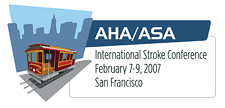PREVAIL: Enoxaparin shown superior to unfractionated heparin
Enoxaparin may become the preferred VTE prophylaxis for acute ischemic stroke patients.
SAN FRANCISCO — Enoxaparin was superior to unfractionated heparin, with a 43% relative risk reduction of venous thromboembolism events, according to results from the PREVAIL study.
“[T]he benefits extended out to 48 hours beyond stroke onset with initiation of treatment,” said David G. Sherman, MD, professor in the department of medicine at the University of Texas Health Science Center in San Antonio. He spoke at the American Heart Association/American Stroke Association International Stroke Conference 2007.
PREVAIL (Prevention of VTE After Acute Ischemic Stroke with Low-Molecular-Weight Heparin Enoxaparin) is the first, large-scale, multinational study to assess the superiority of low-molecular-weight heparin enoxaparin (Lovenox, Sanofi Aventis) over unfractionated heparin (UFH) for VTE prophylaxis. Efficacy endpoints of the trial included bleeding, deep-vein thrombosis mortality, symptomatic pulmonary embolism, bleeding, mortality and stroke recurrence or progression.
PREVAIL
 Within 48 hours of
symptom-onset, researchers randomly assigned 1,762 patients with acute ischemic
stroke confirmed via CT or MRI who were unable to walk unassisted due to
weakness of the affected leg to receive 40 mg enoxaparin daily or 5,000 IU UFH
treatment for 10 days. In 36% of patients, prophylaxis was started less than 24
hours after stroke onset and within 24 to 48 hours in 64%.
Within 48 hours of
symptom-onset, researchers randomly assigned 1,762 patients with acute ischemic
stroke confirmed via CT or MRI who were unable to walk unassisted due to
weakness of the affected leg to receive 40 mg enoxaparin daily or 5,000 IU UFH
treatment for 10 days. In 36% of patients, prophylaxis was started less than 24
hours after stroke onset and within 24 to 48 hours in 64%.
Asymptomatic patients were assessed with bilateral contrast venography of the lower extremities. The researchers excluded patients with evidence of DVT or pulmonary embolism, evidence of active bleeding, a history of intracranial hemorrhage, or major surgical procedures in the previous three months.
The population consisted predominantly of men, average age 66. Twenty-two percent to 26% of patients scored greater than 14 on the National Institutes of Health Stroke Survey (NIHSS). Average time to treatment was 1.2 days, with an average of 10.5 days for duration of treatment.
Researchers followed up at 30, 60 and 90 days.
Enoxaparin superior to UFH
VTE events occurred in 18.1% of patients treated with UFH and 10.2% of patients treated with enoxaparin (RR=0.57; 95% CI, 0.44-0.76), reflecting a 43% relative risk reduction of primary outcomes for the enoxaparin group. There was also a 53% reduction in proximal DVT among enoxaparin group participants compared with the UFH group.
“The patients who had the more severe strokes (score of >14 on the NIHSS) were at much greater risk for developing DVT or pulmonary embolism, about twice that of the patients with less severe strokes,” Sherman said.
Clinically important bleeding occurred in 0.7% of the UFH group and 1.3% of the enoxaparin group (P=.23).
“Risk for intracerebral hemorrhage was not different based on timing of treatment,” Sherman said.
At 90 days, there was no significant difference in stroke recurrence (1.5% in the UFH group vs. 1.7% in the enoxaparin group) and stroke progression (5.3% vs. 5%).
“In conclusion, enoxaparin was superior in the PREVAIL study in reducing VTE [events] by 43%,” said Sherman. “This was consistent in patients with proximal DVT and venous thromboembolism. It was present regardless of the severity of the stroke, and the benefits extended out to 48 hours beyond stroke onset with initiation of treatment.
“It didn’t impact neurologic outcome, which we anticipated; there was clear net benefit of enoxaparin over unfractionated heparin when we considered both efficacy and safety, and we believe that the PREVAIL study suggests that enoxaparin may become the preferred choice of prophylactic management for the stroke patients, for DVT and pulmonary embolism.” – by Judith Rusk
Dr. Sherman is a paid consultant for Sanofi-Aventis.
For more information:
- Sherman DG. Venous thromboembolism prophylaxis with enoxaparin vs. unfractionated heparin and timing of initiation in acute ischemic stroke patients. Plenary Session III. Presented at: American Heart Association/American Stroke Association International Stroke Conference 2007; Feb. 7-9, 2007; San Francisco.
